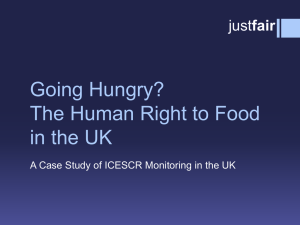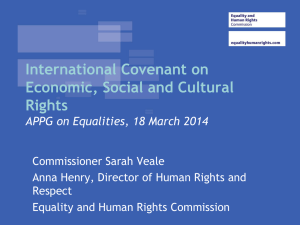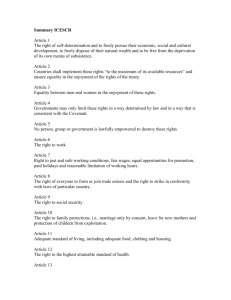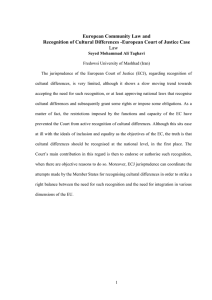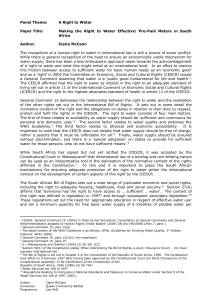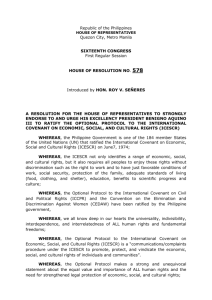Document 17690278
advertisement
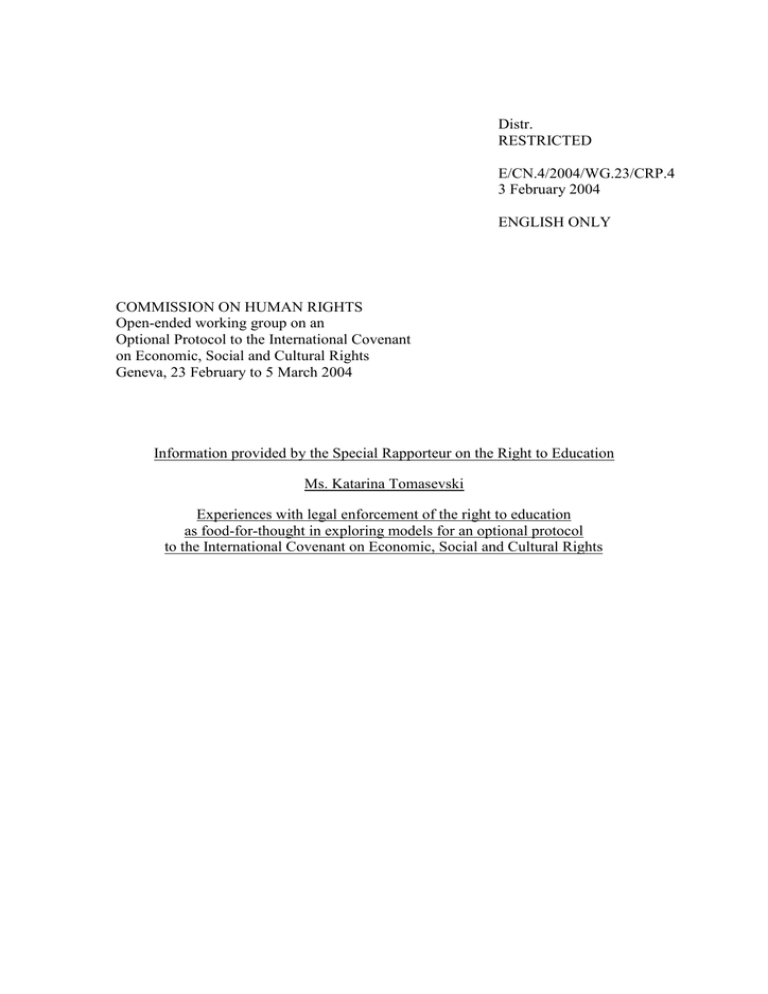
Distr. RESTRICTED E/CN.4/2004/WG.23/CRP.4 3 February 2004 ENGLISH ONLY COMMISSION ON HUMAN RIGHTS Open-ended working group on an Optional Protocol to the International Covenant on Economic, Social and Cultural Rights Geneva, 23 February to 5 March 2004 Information provided by the Special Rapporteur on the Right to Education Ms. Katarina Tomasevski Experiences with legal enforcement of the right to education as food-for-thought in exploring models for an optional protocol to the International Covenant on Economic, Social and Cultural Rights E/CN.4/2004/WG.23/CRP.4 Page 2 1. The invitation of the Commission on Human Rights (resolution 2003/18) to submit my views and recommendations to the Open-ended Working Group on an optional protocol to the International Covenant on Economic, Social and Cultural Rights (the ICESCR) is a welcome opportunity to summarize experiences with the legal enforcement of the right to education at domestic, regional and global levels. This may constitute a useful background for the Working Group for shifting from discussing justiciability to examining the existing jurisprudence. Indeed, ample jurisprudence demonstrates that the right to education is constantly litigated, both domestically and internationally. Lessons learned from the legal enforcement of the right to education may provide an incentive to explore different substantive and procedural options regarding an optional protocol intended to encompass other economic, social and cultural rights. The Working Group may therefore wish to examine these experiences with a view to three key questions which the existing jurisprudence raises. They are, first, presented in a summarized form, and then described in more detail. a) Legal enforcement of the right to education does not encompass its entire scope which the International Covenant on Economic, Social and Cultural Rights anticipated at the time when its text was adopted, 38 years ago. This raises important questions about the potential and limitations of legal enforcement for all economic, social and cultural rights as these were listed and defined in the ICESCR in 1966. The Working Group may wish to accommodate the need for an interpretation of the rights and corresponding government obligations in line with changes in international human rights law which regulates economic, social and cultural rights and the associated jurisprudence. This may provide ideas for mapping out the substantive contents of a possible optional protocol to the ICESCR. b) An immensely helpful interpretative principle in the jurisprudence on the right to education has been the indivisibility and inter-relatedness of human rights. This has facilitated domestic and international legal enforcement through a focus on government human rights obligations derived from human rights law as a whole. A useful topic for the Working Group to explore may be an addition of rights-based to treaty-based approach in contemplating models of legal enforcement. Using the existing network of global and regional human rights treaties as the framework would considerably facilitate the consolidation of experiences with legal enforcement of economic, social and cultural rights which these affirm. Moreover, the global consensus reached regarding key targets for the new millennium might enable the Working Group to initially focus on those parts of the ICESCR which articulate the human rights contents of the globally agreed upon targets. This may facilitate an agreement on substantive delimitations regarding the rights to be encompassed by an optional protocol to the ICESCR. c) The development of international law which took place subsequent to the adoption and entry into force of the ICESCR require its interpretation to be adjusted to the changes within the law itself. The Convention on the Rights of the Child (CRC) introduced in 1989 a definition of the right to education which is substantively different from that provided by the ICESCR. Moreover, the advent of international trade in services, in 1995, which affects the right to E/CN.4/2004/WG.23/CRP.4 Page 3 education as well as many other rights listed in the ICESCR, raises important – and new – questions of conflict between international human rights law and international trade law. In this area, the jurisprudence generated by the European Court of Justice usefully demonstrates the potential for upholding the key components of the right to education alongside the evolving law of trade in education services. 2. The premise of this contribution is that human rights law has introduced the affirmation of each individual as the subject of rights and, consequently, a broad standing for claiming and vindicating human rights. Because no right can exist without remedy, the recognition of a human right entails the corresponding legal standing to claim it and demand remedies for their denial or violation. A powerful incentive for the efforts throughout the past decades to design an appropriate optional protocol has been the fact that this approach was not embodied in the text of the ICESCR when it was adopted. This contribution adopts this fact as the point of departure. It acknowledges that the ICESCR would have been drafted differently had an optional protocol providing for individual complaints been envisaged. Hence, it does not follow widespread suggestions that the entire ICESCR (that is, all the rights listed therein, and the whole scope of the rights as listed) be deemed suitable for any type of legal enforcement that could be envisaged in an optional protocol. 3. International complaints procedures are based upon domestic justiciability of human rights. Indeed, the evolution of human rights law has been accompanied by setting up domestic institutional infrastructures for providing remedies for their denials and violations, both legal and extra-legal. Courts and human rights commissions have become involved in vindicating human rights in all regions of the world. Contrary to the frequent view of enforceable human rights as only civil and political, human rights commissions in many countries tend to have much of their caseload dominated by complaints against violations of economic, social and cultural rights. The insights and experiences of such commissions, especially from developing countries, could provide inspiration by replicating and/or adapting innovative models for the enforcement of economic, social and cultural rights. Since the ICESCR anticipated legislation as only one of the necessary means for putting into practice safeguards for economic, social and cultural rights, the means for enforcement of these rights can also be defined broadly to include legal as well as extra-legal means. I. Delineating the scope of legal enforcement: the ICESCR and exogenous interpretative influences 4. The right to education is regulated by all major global human rights treaties and has generated decisions on international complaints where such treaties include possibilities for doing so, regionally and globally. Asking whether the right to education is justiciable elicits, therefore, an unambiguously positive answer. A pertinent question is, then, which components of the right to education are – and are not – justiciable in view of its definition in the ICESCR. Much of this definition is repeated, often verbatim, in other human rights treaties and indicates a huge potential for the enforcement of the right to education under the ICESCR. 5. Answering the question about a scope of economic, social and cultural rights susceptible to justiciability requires a general point to be made about their listing and E/CN.4/2004/WG.23/CRP.4 Page 4 definitions and – much more importantly – their interpretations. This point relates to the time and circumstances when the ICESCR was drafted and adopted, the profound influence of the cold-war, the varying concepts of economic, social and cultural rights which found their way into the text of the ICESCR but, much more, into its interpretations. 6. As is well known, the Universal Declaration of Human Rights was to be followed by a “universal human rights treaty” until 1952, when the strategy changed to drafting two treaties. 1 The model of separating human rights into two Covenants, and the endowment of civil and political rights alone with legal enforcement and the associated possibility for international complaints, was not used in the Convention against Racial Discrimination (CERD) nor in the Convention on the Elimination of All Forms of Discrimination against Women (CEDAW). Significantly, the principle of non-discrimination was strengthened by those legal developments into a veritable gateway towards human rights jurisprudence which affirmed the inter-relatedness and justiciability of all human rights. 7. The range of economic, social and cultural rights that are internationally justiciable provides an excellent opportunity to review the confluence of parallel international legal guarantees for economic, social and cultural rights listed in the ICESCR. The text of the ICESCR and, in particular, its previous interpretations should be, in my view, carefully reviewed so as to identify those features of the past decades that no longer influence the practice of the overwhelming majority of states. One example suffices to illustrate the importance of such a review. The right to work was seen as geopolitically limited in 1975, with the praise of “the State [which], through its planning organs, accepts responsibility for the maintenance of full employment” and the unquestioning acceptance of “the official statements that unemployment does not exist” by governments of the socialist countries of Eastern Europe. The developed market-economy countries encountered critique because “the meaningful exercise of a right to gain one’s living by work which one freely chooses or accepts is not yet a reality for a portion of the population.” 2 Similar misinterpretations of the nature of the right to education were also widespread, indeed they still are. They were based on a selective reading of the text of the ICESCR but have, sometimes, distorted definitions of economic and social rights converting them into provision and, indeed, imposition of services by the state in denial of individual freedom of choice. 8. Another important issue for the Working Group to consider is the impact of general comments of the Committee on Economic, Social and Cultural Rights on the prospects for an optional protocol to the ICESCR. The Committee has adopted various general comments which reach far beyond the text of the ICESCR. For example, the Committee adopted a general comment on persons with disabilities and 1 The General Assembly pursued the plan for a single, universal human rights treaty as late as 1950 (resolution 412 (V) of 4 December 1950) to alter it in 1952 and call for the drafting of two treaties, one on civil and political, and another on economic, social and cultural rights (resolution 543 (VI) of 5 February 1952). 2 The Realization of Economic, Social and Cultural Rights: Problems, Policies, Progress by Manouchehr Ganji, Special Rapporteur of the Commission on Human Rights, United Nations, New York, 1975, pp. 134, para. 13, 138, para. 28, and 208-209, para. 29. E/CN.4/2004/WG.23/CRP.4 Page 5 another on older persons, acknowledging in both cases that the ICESCR did not mention these issues, 3 and many similar examples could be added. It was, perhaps, the knowledge that the ICESCR was not justiciable that inspired the Committee to amplify its remit and broaden definitions of economic, social and cultural rights, with a justification that other human rights treaties as well as domestic laws went beyond the ICESCR. While this practice would support a rights-based rather than treaty-based human rights approach, it undermines the principle of legal security by reading into a legal text a contents which simply is not there. A helpful interpretative principle may therefore be a focus on the legal meaning of economic, social and cultural rights as affirmed in international and domestic jurisprudence. For the purposes of legal enforcement, this can be attained by a focus on government human rights obligations. II. Rights-based approach in jurisprudence: focus on government human rights obligations 9. This contribution applies a typology of government human rights obligations which has been developed for the right to education. It is used here to present interesting examples from jurisprudence as both the typology and substantive issues raise questions that apply to other economic, social and cultural rights. The advantage of not being a treaty-based body has enable me to systematize and analyse all international human rights law that regulates the right to education and to review the practice of states so as to extract those human rights obligations that are affirmed in the major sources of international law. 10. This typology is different from the one originally developed for the right to food, which categorizes government obligations into respect, protect and fulfil. Unlike selfprovisioning which characterizes the dominant interpretation of the right to food for the vast majority of people in the world, 4 a key government obligation in education is that of result, namely to secure free and compulsory education for all children. Since children are the privileged subjects of the right to education and education has been defined for them as compulsory, the provision or financing of compulsory education forms the practice of the overwhelming majority of states. This, however, does not undermine other government obligations in education which apply in parallel, such as to respect parental freedom of choosing education for their children or to safeguard human rights in education. Government human rights obligations are thus structured into a 4-A scheme: a) Availability encompasses different types of governmental obligations. The right to education as a social and economic right requires, most importantly, 3 General comment 5, para. 6, and general comment 6, Compilation of general comments and general recommendations adopted by human rights treaty bodies, HR/GEN/1/Rev.3 (1997), para. 10, pp. 73 and 85. 4 As formulated by Asbjorn Eide, ”state obligations must be seen in the light of the assumption that human beings, families and wider groups seek to find their own solutions to their needs, states should, at the primary level, respect the resources owned by the individual and the individual’s freedom to find a job of preference, to make optimal use of her or his own knowledge and to take the necessary actions and use the necessary resources – alone or in association with others – to satisfy his or her own needs.” The Right to Food in Theory and Practice, Food and Agriculture Organization of the United Nations, Rome, 1998, p. 4. E/CN.4/2004/WG.23/CRP.4 Page 6 the government to ensure that free and compulsory education is available to all school-age children. As a civil and political right, the right to education requires the government to permit the establishment of educational institutions respecting freedom of and in education. The right to education as a cultural right requires adaptation of education to diversity and safeguards for, especially, minority and indigenous rights. b) Accessibility is defined differently for different levels of education. The government is obliged to secure education for all children in the compulsory education age-range, eliminating all obstacles, especially those emanating from internationally prohibited discrimination. The explicit wording of the ICESCR regarding secondary and higher education has been affected by the advent of trade in education services and the corresponding change in the practice of states. (This is dealt with in section 3. below.) Compulsory education ought to be free of charge while post-compulsory education may entail the payment of tuition and other charges. This practice is contrary to the explicit wording of the ICESCR, which anticipated that the right to education would be realized progressively, ensuring all-encompassing free and compulsory education as soon as possible, and broadening post-compulsory education as circumstances permit. c) Acceptability requires minimum guarantees for the quality of education to be set, monitored and enforced by the government throughout education, whether educational institutions are public or private, and it goes much further. Acceptability has been broadened through international human rights law to encompass the medium, contents and methods of instruction. Indigenous and minority rights have prioritized the language of instruction; the contents of educational curricula and textbooks are increasingly examined and altered using human rights as the yardstick; the prohibition of corporal punishment has transformed methods of instruction and school discipline. d) Adaptability requires schools to adapt to children, following the best interests of each child affirmed in the Convention on the Rights of the Child. This change reversed the heritage of forcing children to adapt to whatever schools may have been made available to them. As human rights are indivisible, adaptability requires safeguards for all human rights in education as well as enhancing human rights through education. II.1. Availability 11. International human rights law posits free and compulsory primary education as government responsibility. The rationale for requiring compulsory education to be free is that all financial obstacles ought to be eliminated, otherwise education cannot be universalized. As long as families cannot afford the cost of education, compulsion cannot be enforced. For children without a supportive family, the state has to act in loco parentis. Court cases against parents who breached compulsory education laws when they could not afford the cost of schooling have been futile everywhere in the world, clearly demonstrating why international law has made education free. Court cases against governments can only be effective when they have both the willingness and the capacity to translate human rights guarantees into practice. The African E/CN.4/2004/WG.23/CRP.4 Page 7 Commission on Human and Peoples’ Rights found that a two year long closure of universities and secondary schools in Zaire (as it was at the time) constituted a violation of Article 17 of the Charter, which guarantees the right to education. 5 Thus, the commitment of a government to make and keep education available reaches far beyond resources. 12. It is proverbial that government human rights obligations ought to be – but are often not - translated into corresponding fiscal allocations. Where education receives less funding than would be necessary to ensure the minimum, namely free and compulsory education for all children, the main reason routinely transpires to be that educational allocations are discretionary. As long as they remain political decisions, they cannot be justiciable. Constitutionalizing budgetary allocations for education as 25% of government budget or 6% of GNP moves them from the realm of political discretion into the rule of law. This change has triggered constitutional jurisprudence in countries as different as Hungary and the Philippines. 6 An additional step is a clearly established government obligation to ensure free education for all school age children. In England, the duty of local education authority to secure sufficient places at school for all children within the compulsory school age was not fully implemented and 300 children were deprived of primary education because of a shortage of teachers. Reacting to that complaint, the court has held that the authority did whatever was in its powers to rectify the situation and was thus not in breach of its statutory duty. 7 The definition of “free” has generated a great deal of jurisprudence. The Constitutional Court of the Czech Republic has dealt with a demand upon government to provide textbooks and teaching materials free of charge. It has clarified that in primary and secondary education “the State [bears] the costs of establishing schools, their operation and maintenance, but above all it means that the state may not demand tuition”. 8 In Brazil, free and compulsory education as an individual public right has been interpreted to also include free transport if children cannot otherwise attend school. 9 The meaning of “free” has gone much further in jurisprudence, beyond direct and indirect costs of schooling, to also eliminate opportunity costs. The Supreme Court of India has accepted a “learn and earn” approach for non-hazardous employment of children below 14 years of age, mandating a reduction of their daily African Commission on Human and Peoples’ Rights - Free Legal Assistance Group, Lawyers Committee for Human Rights, Union Interafricaine des Droits de l’Homme, Les Témoins de Jehovah v. Zaire, Communications 25/89, 47/90, 56/91 and 100/93 (joined), Decision of the Commission adopted at its 18th ordinary session at Prais (Cape Verde), Ninth Annual Activity Report of the African Commission on Human and Peoples’ Rights 1995/96, Assembly of Heads of State and Government, Thirty-second Ordinary Session, 7-10 July 1996, Yaounde, Cameroon. 5 6 Report of the Special Rapporteur on the right to education, U.N. Doc. E/CN.4/2001/52, para. 72; Zifzak, S. – Adjudicating social rights: Lessons from the Hungarian constitutional experience, East European Human Rights Review, vol. 4, 1998, No. 1, pp. 53-96. 7 R. v. Inner London Education Authority, ex parte Ali, [1990] C.O.D. 317, [1990] 2 Admin.L.R. 822, 828B. 8 Constitutional Court of the Czech Republic - Judgment US 25/94 of 13 June 1995. 9 Tribunal of the State Minas Gerais (TMG), Apelação Civel No. 000.197.843-6/2000. E/CN.4/2004/WG.23/CRP.4 Page 8 working hours to six with at least two hours of education at the expense of the employer. For hazardous work, the Court has recalled that child labour could not be eliminated without tackling the underlying poverty and suggested ensuring work for an adult member of the family in lieu of the child or, if this is impossible within the limits of the economic capacity of the country, the provision of a minimum income to the family in order to enable them to send the child to school payable as long as the child is attending school. 10 13. The capacity of individual governments to ensure free and compulsory education can be jeopardized by factors beyond their control, especially international. My forthcoming annual report summarizes developments regarding possibilities for the elimination of school fees in primary education within global education strategies and this cannot be repeated here. It needs to be said, however, that law has been absent thus far from global development strategies to the detriment of economic, social and cultural rights. Bringing law to bear on global debt relief or poverty reduction strategies is, as yet, an unmet challenge. This process can be facilitated by integrating (or, as is often said “mainstreaming”) human rights as this opens the way for the rule of law, which the Millennium Declaration affirms. 11 Since the millennium development goals repeat much of the substance of the ICESCR, the Working Group may wish to explore the option of elaborating an optional protocol which would focus on those economic, social and cultural rights whose substance is also included in millennium development goals. II.2. Accessibility 14. The realization of the right to education is a continuing process and elimination of discrimination is an immense challenge, everywhere. Categories that have been historically excluded from education necessarily display a lower educational status. Hence, international human rights law demands that discrimination be not only prohibited but also eliminated, notably for girls and women as well as all victims of racial discrimination. Prohibiting denial of education to a child because she is female or belongs to a minority or is disabled - or all of these - is the first step towards affirming the universality of the right to education. 15. There is a vast amount of jurisprudence regarding discriminatory denials of education according to all internationally prohibited grounds and many additional ones. A particularly frequent exclusionary criterion has been the lack of citizenship, and the Inter-American Commission on Human Rights has made impressive progress in affirming education as a human right of all children. 12 The rationale of the US Supreme Court has been to emphasize that denial of access to education “is directed against children, and imposes its discriminatory burden on the basis of a legal 10 Supreme Court of India - Mehta v. State of Tamil Nadu, Judgment of 10 December 1996, (1996) 6 SCC 756; AIR 1997 SC 699; (1997) 2 BHRC 258. 11 United Nations Millennium Declaration, U.N. Doc. A/RES/55/2 of 18 September 2000, para. 8. 12 Comisión Interamericana de Derechos Humanos – Caso 12.189 Dilcia Yean y Violeta Bosica v. República Dominicana, Informe no. 28/01. E/CN.4/2004/WG.23/CRP.4 Page 9 characteristic over which children have little control,” and to highlight the cost of denying education: “It is difficult to understand precisely what the State hopes to achieve by promoting the creation and perpetuation of a subclass of illiterates within our boundaries, surely adding to the problems and costs of unemployment, welfare and crime. It is thus clear that whatever savings might be achieved by denying these children an education, they are wholly insubstantial in light of the costs involved to these children, the State and the Nation.” 13 16. Objective and justifiable criteria for refusal of admission to educational institutions have been upheld by courts in many cases. The requirement for a child to reach a specific age for admission to school belongs to such objective criteria, as does the prerequisite of immunization. The Human Rights and Equal Opportunity Commission of Australia dismissed a complaint against the refusal of admission of children to a child care centre, finding that “the exclusion of unvaccinated children from day care centres was reasonably necessary to protect public health.” 14 For the higher levels of education, the European Commission on Human Rights held that the restriction of access to academic studies to those applicants who have previously attained a sufficiently high level of education to be able to successfully follow the courses did not constitute a denial of the right to education. 15 The Supreme Court of Colombia has affirmed that the maintenance of academic excellence necessitates the establishment and enforcement of selection criteria by universities, which are legitimate as long as they are purely academic. 16 II.3. Acceptability 17. Commonly used definitions of quality reflect the key purpose of education, namely ensuring that all conditions determining the learners’ achievement are in place. Differences between and within countries reveal, on the one hand, an insufficient number of schools without essential safety and environmental health safeguards as well as untrained and, often, unpaid teachers and, on the other hand, education that produces outcomes ranked high within internationally administered tests of learning accomplishments. The government obligation to define and ensure the quality of education requires defining standards that should be in place everywhere and identifying (or creating) institutions and procedures whereby these standards will be implemented, monitored, and enforced. 18. Human rights law broadens the purview to all rights of all key actors in education. As UNESCO has put it, “the inclusion of human rights in education is a key element of a quality education.” 17 This entails an altered design of education strategies, which 13 US Supreme Court - Plyer v. Doe, 457 U.S. 202, 15 June 1982. 14 Human Rights and Equal Opportunity Commission of Australia - Greg Beattie (on behalf of Kiro and Lewis Beattie) v Maroochy Shire Council, No. H96/87, 20 December 1996. 15 European Commission on Human Rights - X. v. United Kingdom, Application No. 8844/80, Decision of 9 December 1980, Decisions & Reports, vol. 23, 1981, p. 228. 16 Supreme Court of Colombia - Judgment of 3 July 1998, T-326. 17 UNESCO Executive Board - Elements for an overall UNESCO strategy on human rights, E/CN.4/2004/WG.23/CRP.4 Page 10 should accommodate the minimum universal human rights standards pertaining to the actors: the learners, their parents and their teachers. An example are teachers’ rights. Trade union freedoms form part of the fundamental international labour standards, which are legally enforceable in many countries as well as internationally. Jurisprudence spans a wide range of issues. The Equal Opportunity Commission of the Netherlands has affirmed that homosexuality is not a legitimate ground to refuse to recruit a teacher. 18 There has been no hesitation on the part of courts to affirm that teachers ought to be qualified to teach, including the perfect command of the language in which they are expected to teach. 19 South Africa’s Constitutional Court has addressed the problem of resort to “contract teachers,” faulting a requirement for teachers to be citizens. The Court has found that “non-citizens are a minority in all countries and have little political muscle.” It rejected the government’s justification for the denial of teaching posts to non-citizens so as to provide employment to its own citizens by giving preference to the provision of quality education. 20 The Supreme Court of Canada has justified a dismissal and a subsequent criminal conviction of a teacher who had “taught his classes that Jewish people seek to destroy Christianity and are responsible for depressions, anarchy, chaos, wars and revolution”, expecting his students to reproduce his teaching during exams and penalizing them by bad marks if they failed to do so. 21 II.4. Adaptability 19. Since human rights are interrelated and interdependent, the enjoyment of the right to education unlocks other human rights, while its denial precludes the enjoyment of most, if not all, other rights. The requirement of adaptability has reversed the heritage of forcing children to adapt to whatever schools may have been made available to them. Alongside transmission of knowledge, education is the key vehicle for intergenerational transmission of values, and schooling is the main forms of institutionalized socialization of new generations. Thus, adaptability requires safeguards for all human rights in education as well as enhancing human rights through education. 20. Most imaginative jurisprudence has been generated regarding children with disabilities. The principle of non-discrimination has been interpreted to necessitate a comparison between learners with and without disabilities in order to detect and eliminate less favourable treatment of learners with disabilities. A distinction between meeting their special needs and a positive obligation to treat them more favourably has been discussed by the Federal Court of Australia. The Court has found that the accommodation of special needs sometimes requires positive action to be taken but Doc. 165 EX/10 (2002), para. 31. 18 Equal Opportunity Commission of the Netherlands - Ruling 1999-38 of 29 April 1999. Human Rights and Equal Opportunity Commission of Australia - Maria D’Souza v. Peter Geyer and Directorate of School Education, No. H94/100, 1995-1996, and T. v Department of Education of the State of Victoria, No. H96/149, 1 July 1997. 19 20 Constitutional Court of South Africa - Larbi-Odam v. The Member of the Executive Council for Education (North-West Province), SA 745 (CC), 1998. 21 Supreme Court of Canada - R.V. v. Keegstra, [1990] 3 S.C.R., 697, p. 714. E/CN.4/2004/WG.23/CRP.4 Page 11 has not accepted the reasoning of the Human Rights and Equal Opportunity Commission whereby the yardstick should be a school’s effort defined as “what the school ideally ought to have done.” Rather, the Court has confirmed that nondiscrimination required a comparison between the treatment of the learner with disabilities with that of a learner without disabilities in the same circumstances.22 21. The German Federal Constitutional Court has held that the general approach favouring inclusive education does not diminish the need to review the circumstances of each individual case, giving particular weight to the views of the child and his or her parents: “Education should be integrated, providing special support for disabled pupils if required, so far as the organizational, personal and practical circumstances allow this. This reservation is included as an expression of the need for the State to consider all the needs of the community in carrying out its duties, including the financial and organizational factors. 23 22. Methods of teaching and administration of school discipline have triggered many court cases, worldwide. A teacher had been dismissed in Latvia in 1995 for immoral behaviour and challenged his dismissal. The court has held that the teacher’s physical abuse of school children (hitting them on the chin with his fist or lifting them by their ears) was contrary to articles 19 and 28 of the Convention on the Rights of the Child, that such treatment “is not permissible in the education of children, even if they are difficult, unmanageable children with a bad record of learning and discipline.” 24 The Constitutional Court of Colombia has found that exclusion constituted a disproportionately harsh punishment for the offence of a boy’s long hair. It has found the requirement by the school for the boy to have a haircut justified, but it faulted the expulsion imposed for his refusal to have been disproportionate as well as a violation of the boy’s right to education. 25 The High Court in Lilongwe (Malawi) dealt in 1996 with another case of expulsion. As in most countries, the girl who had been expelled did not have standing to challenge her expulsion and the suit was initiated by her father. At issue was her participation in the protest march in March 1996 which had led to the closure of her school and her father’s receipt, a month later, of a notice that his daughter had been expelled for misconduct. The court has found that the failure of the school to “give her a real opportunity to be heard” made the expulsion null and void. 26 23. The exit of learners from education into society demands scrutiny by human rights criteria. Where learning outcomes are satisfactory but graduates are, 22 Federal Court of Australia - A school v Human Rights & Equal Opportunity Commission & Anor [1998] 1437 FCA, 11 November 1998. 23 Federal Constitutional Court of Germany - Decision of 8 October 1997, 1 BvR 9/97. 24 Bauska District Court - Kazarovecs v. Iecava High School, Case No. 2-860-3, 18 May 1995. 25 Supreme Court of Colombia - Judgment T-124 of 31 March 1998. 26 High Court (Lilongwe) - Upile Chioza (a minor) suing by Andrew Chioza as her next friend v. Board of Governors of Marymount Secondary School, No. 254 of 1996, 19 July 1996. E/CN.4/2004/WG.23/CRP.4 Page 12 nevertheless, doomed to unemployment, the need for cross-sectoral linkages become apparent and the principle of indivisibility of human rights immensely useful. The phenomenon of graduate unemployment indicates the need to closely link education and the labour market (including employment and self-employment, formal and informal sectors). In jurisprudence, this has been best elaborated by the European Court of Justice, which has singled out the vocational purposes of education, including university education. 27 Furthermore, these cross-sectoral linkages require creation and enforcement of laws and regulations on mutual recognition of degrees and qualifications which constantly creates a great deal of jurisprudence. III. Adjusting the interpretation of the ICESCR to subsequent legal changes 24. The ICESCR affirmed that everybody had the right to education and anticipated progressive realization of the right to free education for youth and adults, differently from the subsequent Convention on the Rights of the Child (CRC). The CRC Convention, drafted in the 1980s, reflected the trend of the 1980s to diminish the entitlement to free education to children alone and, probably, anticipated that the practice of states would change further away from the wording and spirit of the ICESCR. Indeed, contrary to the anticipated progressive introduction of free education, post-compulsory education has become a traded service. This has exacerbated tendencies of exodus from poorly funded public education throughout the education pyramid in large parts of the world. It has also added importance to the differentiation between public and private, free and for-fee education, which has generated a great deal of jurisprudence. 25. The impact of the double, and mutually contradictory, legal status of education is profound. Since similar legal developments have affected health, housing, and water and sanitation, the Working Group may wish to explore strategies for drafting an optional protocol to the ICESCR that would take account of and respond to the human rights impact of the law on trade in services. 26. In education, the guaranteed freedom and the corollary responsibility of parents to choose education for their children forms part of the definition of the right to education in all relevant human rights treaties, including the ICESCR. The rationale behind parental choice is not to legitimize denial of their children’s education. In the case of a conflict between parental choice and the best interests of the child, the latter prevail. Rather, in the words of the Spanish Supreme Court, the rationale is to disallow state monopoly over education and protect the existence of educational pluralism. 28 There is a great deal of difference in the very classification of schools as public and/or state schools and private schools. The classification developed by UNESCO divides schools by the criterion of their management and “government- 27 In one of the precedent cases, the Court has examined the contents of university education separating those parts which prepare the learners for a profession, trade or employment, which can be defined as vocational, from those which could not be so defined, which are “intended for persons wishing to improve their general knowledge rather than prepare themselves for an occupation”. Commission v. Belgium case 293/85 [1988] ECR, p. 306. 28 Constitutional Court of Spain - Ruling STC 5/1981 of 13 February 1985. E/CN.4/2004/WG.23/CRP.4 Page 13 aided schools are considered private if they are privately managed.” 29 Differently, English courts have classified schools into state (i.e. public) and private by the criterion of their source of funding. If a school’s funding comes out of public revenue, it is defined as a state school regardless of how it is managed. 30 The Human Rights Committee has found that a state “cannot be deemed to act in a discriminatory fashion if it does not provide the same level of subsidy for the two [public and private] types of establishment, when the private system is not subject to State supervision.” In a similar case, the Committee has added that “the preferential treatment given to public sector education is reasonable and based on objective criteria.” 31 Differently, the Constitutional Court of Spain invoked Article 13 of the International Covenant on Economic, Social and Cultural Rights and interpreted it to require from the state evenhandedness in funding public and private schools. The obligation of the state, the Court has held, is to make education in both public and private schools free of charge and grant scholarships to learners regardless of the school they have chosen. 32 27. The evolving law that regulates international trade in education services under the GATS (General Agreement on Trade in Services) recognizes that compulsory education may remain an individual entitlement and a corresponding government responsibility. This option is pursued in the majority of countries in the world. The law allows individual countries to regulate education as a traded service, especially at post-compulsory stages, as is described in my annual reports. 33 The boundaries between the right to free and access to for-fee education are being defined, internationally and domestically. A pioneer has been the European Court of Justice, which has differentiated between education as a paid service from education as an individual entitlement by the criterion of payment, specifying that fee-for-service “is absent in the case of courses provided under the national education system.” 34 The practice within the European Union, where the right to free education has been preserved for children and young people in the compulsory education age, but postcompulsory education – both public and private – is subject to payment, reflects a similar pattern worldwide. It is therefore, in my view, worth the attention of the 29 UNESCO - 1998 World Education Report, Paris, 1999, p. 118. National Union of Teachers v. Governing Body of St.Mary’s Church of England Aided School, [1995] ICR 317, EAT [1997] IRLR 242 (CA); R. v.Haberdashers’ Aske’s Hatcham Trust, ex parte T [1995] ELR 350; EA 1996, ss 482 (1) (b), (3); 483. 30 31 Human Rights Committee - Carl Henrik Blom v. Sweden, Communication No. 191/1985, Views adopted on 4 April 1988, Selected Decisions of the Human Rights Committee under the Optional Protocol, Seventeenth to thirty-second sessions (October 1982 - April 1988), United Nations, New York, 1990, p. 219, para. 10.3; G. and L. Lindgren and L. Holm et. al. v. Sweden, Communications Nos. 298/1988 and 299/1988, Views of the Committee adopted on 9 November 1990, U.N. Doc. CCPR/C/40/D/298-299/1988 of 7 December 1990, para. 10.3. Quoted from: Díaz Revorio, F.J. – El derecho a la educación, Anuario Parlamento y Constitución, vol. 2, 1998, pp. 267-308. 32 33 Commission on Human Rights - Reports of the Special Rapporteur, U.N. Docs. E/CN.4/2003/9, paras. 18-19, and E/CN.4/2002/60, paras. 19-21. 34 Belgian State v. Humbel [1988] ECR 5365, para. 15. E/CN.4/2004/WG.23/CRP.4 Page 14 Working Group. 28. The purpose of this contribution has been to highlight particularly noteworthy issues which have emerged from my study into the jurisprudence on the right to education. The necessity of writing in shorthand to accommodate the United Nations rules on the length of documents prevents detailed examination of the multitude of legal developments and controversies that affect the process of designing an optimal model of an optional protocol to the ICESCR. I shall be happy, of course, to provide any further assistance should the Working Group wish so.
